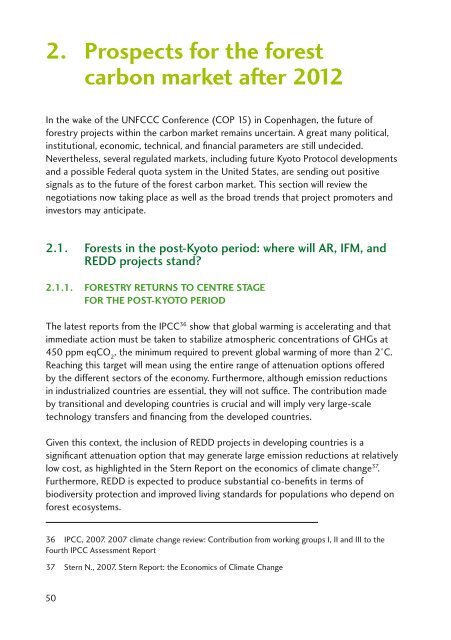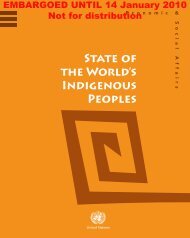Bringing forest carbon projects to the market
Bringing forest carbon projects to the market
Bringing forest carbon projects to the market
You also want an ePaper? Increase the reach of your titles
YUMPU automatically turns print PDFs into web optimized ePapers that Google loves.
2. Prospects for <strong>the</strong> <strong>forest</strong><strong>carbon</strong> <strong>market</strong> after 2012In <strong>the</strong> wake of <strong>the</strong> UNFCCC Conference (COP 15) in Copenhagen, <strong>the</strong> future of<strong>forest</strong>ry <strong>projects</strong> within <strong>the</strong> <strong>carbon</strong> <strong>market</strong> remains uncertain. A great many political,institutional, economic, technical, and financial parameters are still undecided.Never<strong>the</strong>less, several regulated <strong>market</strong>s, including future Kyo<strong>to</strong> Pro<strong>to</strong>col developmentsand a possible Federal quota system in <strong>the</strong> United States, are sending out positivesignals as <strong>to</strong> <strong>the</strong> future of <strong>the</strong> <strong>forest</strong> <strong>carbon</strong> <strong>market</strong>. This section will review <strong>the</strong>negotiations now taking place as well as <strong>the</strong> broad trends that project promoters andinves<strong>to</strong>rs may anticipate.2.1. Forests in <strong>the</strong> post-Kyo<strong>to</strong> period: where will AR, IFM, andREDD <strong>projects</strong> stand?2.1.1. Forestry returns <strong>to</strong> centre stagefor <strong>the</strong> post-Kyo<strong>to</strong> periodThe latest reports from <strong>the</strong> IPCC 36 show that global warming is accelerating and thatimmediate action must be taken <strong>to</strong> stabilize atmospheric concentrations of GHGs at450 ppm eqCO 2, <strong>the</strong> minimum required <strong>to</strong> prevent global warming of more than 2°C.Reaching this target will mean using <strong>the</strong> entire range of attenuation options offeredby <strong>the</strong> different sec<strong>to</strong>rs of <strong>the</strong> economy. Fur<strong>the</strong>rmore, although emission reductionsin industrialized countries are essential, <strong>the</strong>y will not suffice. The contribution madeby transitional and developing countries is crucial and will imply very large-scaletechnology transfers and financing from <strong>the</strong> developed countries.Given this context, <strong>the</strong> inclusion of REDD <strong>projects</strong> in developing countries is asignificant attenuation option that may generate large emission reductions at relativelylow cost, as highlighted in <strong>the</strong> Stern Report on <strong>the</strong> economics of climate change 37 .Fur<strong>the</strong>rmore, REDD is expected <strong>to</strong> produce substantial co-benefits in terms ofbiodiversity protection and improved living standards for populations who depend on<strong>forest</strong> ecosystems.36 IPCC, 2007. 2007 climate change review: Contribution from working groups I, II and III <strong>to</strong> <strong>the</strong>Fourth IPCC Assessment Report37 Stern N., 2007. Stern Report: <strong>the</strong> Economics of Climate Change50
















